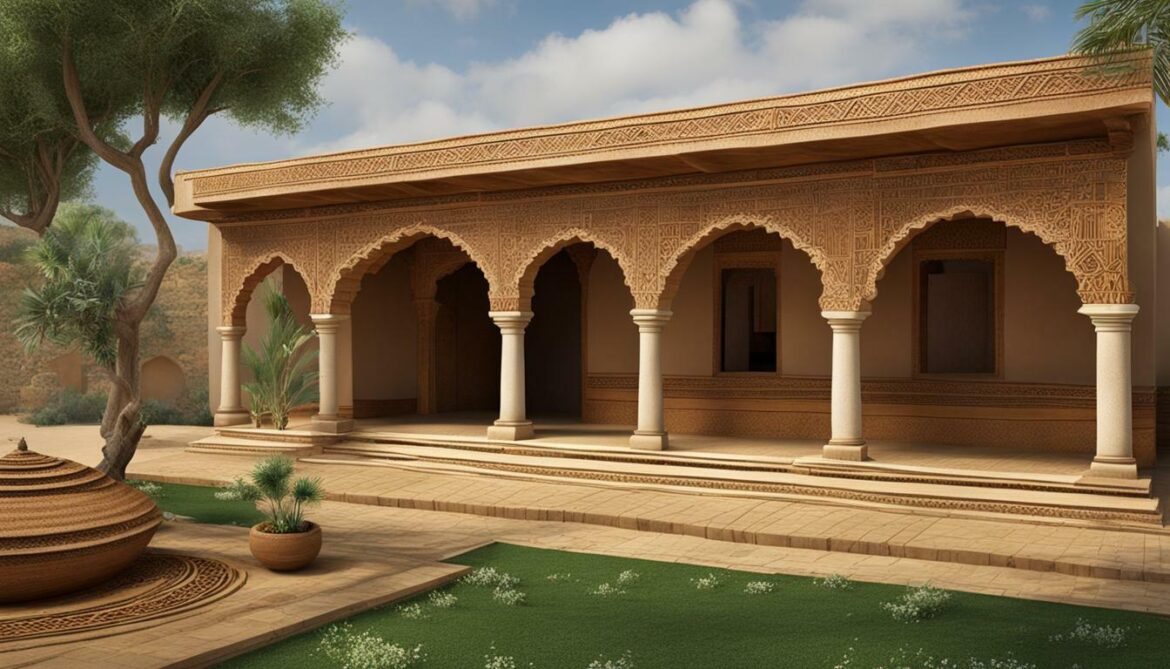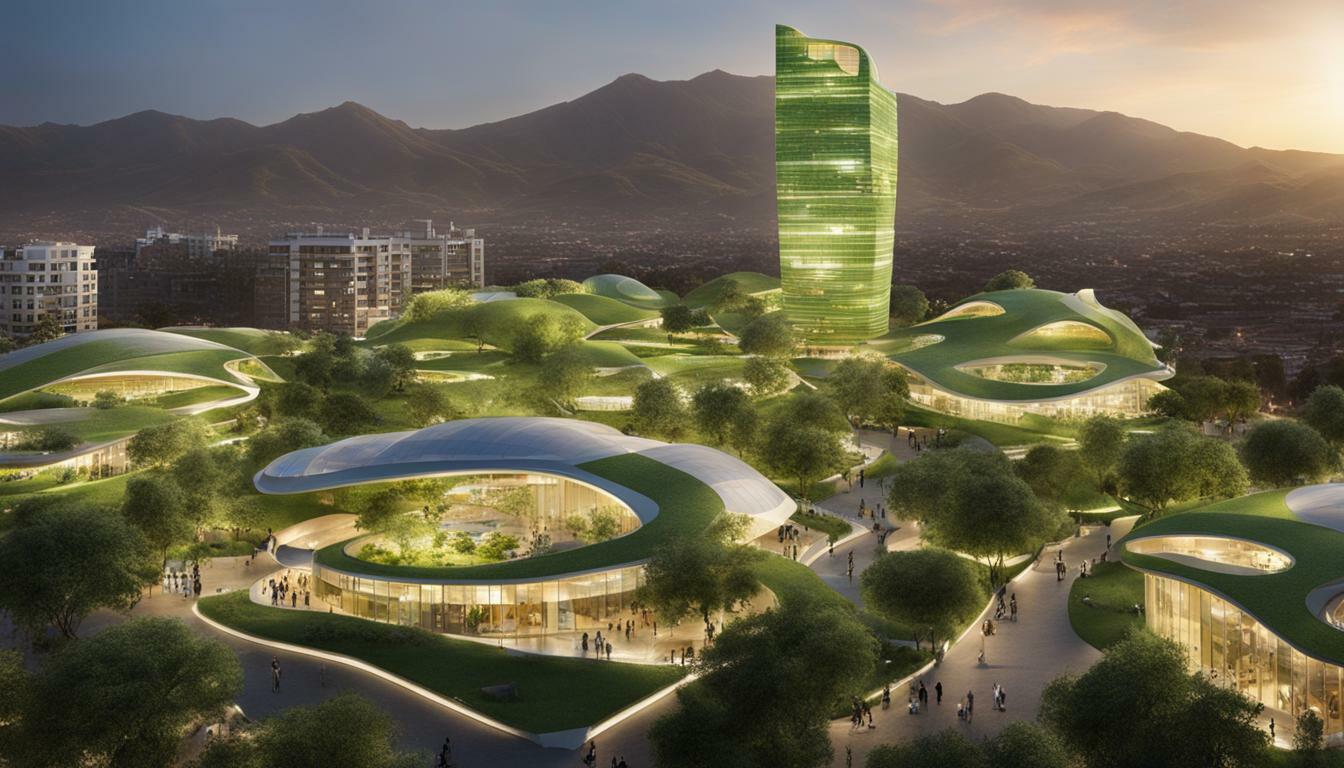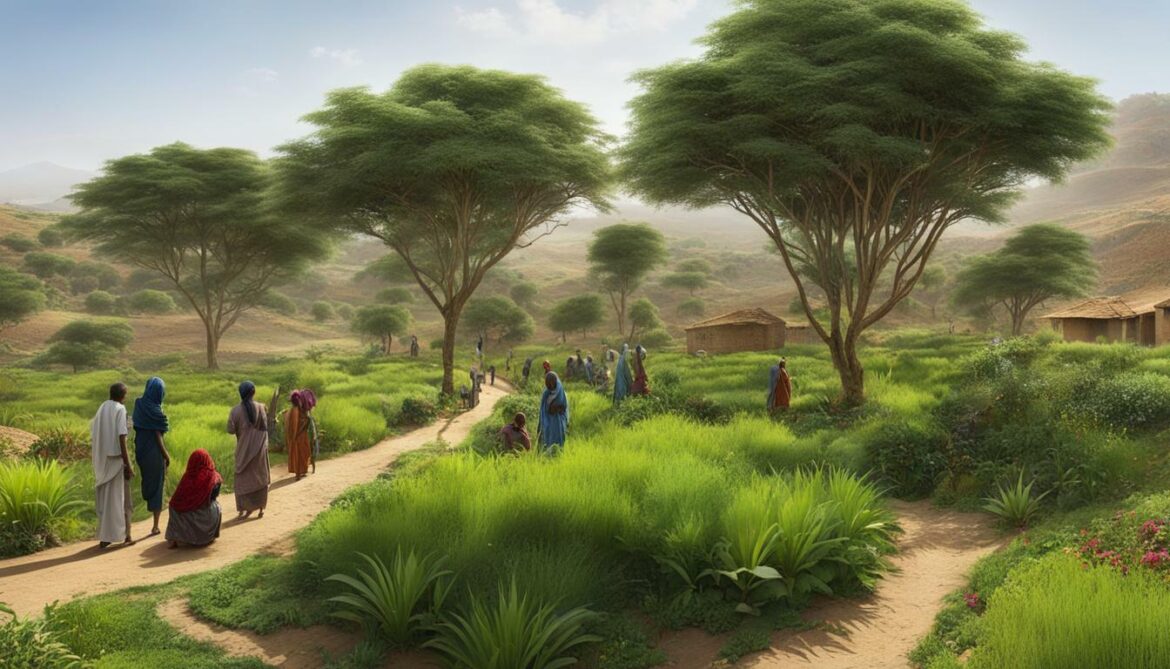Eritrea has a rich history of green building practices, encompassing both modernist influences and traditional architectural techniques. Throughout its colonial past and into the present, the country has been committed to sustainable construction and eco-friendly design.
Key Takeaways:
- Eritrea’s green building history is influenced by its colonial past and traditional architecture.
- During the Italian colonial period, Asmara saw the construction of modernist buildings, some of which are recognized as culturally significant by UNESCO.
- Mud bricks, stone, and wood have been traditionally used in Eritrea’s sustainable construction practices.
- The government has implemented regulations to protect the environment, including the prohibition of plastic bags and the sustainable management of water resources.
- Eritrea promotes community-led conservation efforts and tree planting initiatives to address deforestation and promote a healthier environment.
Colonial Era and Modernist Buildings
During the Italian colonial period, Eritrea witnessed the construction of numerous modernist buildings in Asmara, the capital city. These architectural marvels still stand today, serving as a testament to Eritrea’s rich heritage and commitment to sustainable construction. Notably, the Fiat Tagliero petrol station and the Town Hall are recognized by UNESCO as culturally significant landmarks.

The Fiat Tagliero petrol station, designed by Italian architect Giuseppe Pettazzi, is a striking example of Eritrea’s eco-friendly architecture. Its futuristic design and use of sustainable materials made it a pioneering structure of its time. The station’s cantilevered roof, shaped like an airplane wing, showcases the ingenuity and creativity of Eritrea’s architects.
The Town Hall, another iconic modernist building, incorporates elements of both Italian Rationalism and local architectural traditions. Its symmetrical façade and elegant colonnades create a harmonious blend of colonial influences and Eritrean craftsmanship. The building’s use of natural light and ventilation further emphasizes its eco-friendly design.
| Key Features of Colonial Era and Modernist Buildings |
Architectural Highlights |
| Sustainable Construction Materials |
Mud bricks, stone, and wood |
| Innovative Designs |
Cantilevered roofs, aircraft-inspired structures |
| Blend of Colonial and Local Influences |
Italian Rationalism and Eritrean craftsmanship |
| Eco-friendly Features |
Natural light, ventilation, and energy efficiency |
Eritrea’s colonial era and modernist buildings serve as a source of inspiration for contemporary architects and designers. They demonstrate the country’s commitment to sustainable construction practices and emphasize the importance of preserving Eritrea’s architectural heritage for future generations.
Traditional Architecture and Sustainable Building Materials
Eritrea’s architectural heritage includes the use of sustainable building materials such as mud bricks, stone, and wood, which have been incorporated into modern designs. Throughout its history, Eritrea has relied on these locally sourced materials to construct not only basic residential houses but also significant cultural and religious structures like temples. The integration of traditional architectural features into modern buildings not only pays tribute to the country’s rich heritage but also promotes sustainable design principles.
Traditional Eritrean houses, known as zemene mesker, are constructed using mud bricks, a material that has proven to be durable and environmentally friendly. These bricks are made by mixing clay, sand, and water and then left to dry in the sun. The result is a sturdy and energy-efficient building material that provides natural insulation, keeping the interiors cool during hot summers and warm during cold winters.
Eritrea’s use of stone in construction is also prevalent, particularly in areas with an abundance of natural resources. Stone buildings not only offer aesthetic appeal but also provide excellent thermal mass, further enhancing energy efficiency. The use of locally sourced wood, such as acacia, is another sustainable practice seen in Eritrean architecture. Wood is typically used for structural elements and interior finishes, adding warmth and character to the buildings.
“The integration of traditional architectural features into modern buildings not only pays tribute to the country’s rich heritage but also promotes sustainable design principles.”
This seamless blend of traditional and modern architectural practices in Eritrea not only showcases the country’s unique identity but also demonstrates its commitment to eco-friendly design. By incorporating sustainable building materials into contemporary structures, Eritrea contributes to the preservation of its architectural heritage while also reducing the environmental impact of construction.
Eritrea’s Architectural Heritage in Sustainable Building Materials:
| Material |
Benefits |
| Mud Bricks |
Locally sourced, energy-efficient, and provide natural insulation. |
| Stone |
Offers thermal mass and adds aesthetic appeal. |
| Wood |
Locally sourced, adds warmth and character to buildings. |

Eritrea’s sustainable architecture is not just about preserving the past but also about building a sustainable future. By using materials that are readily available and reducing the reliance on resource-intensive construction methods, Eritrea sets an example for other nations striving to achieve sustainable development and eco-friendly design.
Environmental Regulations and Protection
Eritrea has implemented various regulations and measures to ensure environmental protection and sustainable development. The government recognizes the importance of preserving its natural resources and biodiversity for the well-being of present and future generations.
One of the key areas of focus has been the regulation of plastic bags. Eritrea has taken a proactive approach by prohibiting the production and distribution of plastic bags. This measure aims to reduce plastic waste and its detrimental impact on the environment, including the pollution of land and water sources. By limiting the use of plastic bags, Eritrea is promoting eco-friendly alternatives and encouraging a shift towards more sustainable practices.
Eritrea has also prioritized the regulation of pesticides to protect both human health and the environment. The government has established strict guidelines for the importation and use of pesticides to ensure their safe and responsible application. This measure helps to minimize the negative effects of chemical pesticides on ecosystems and promotes the use of environmentally friendly alternatives.
Additionally, Eritrea has established comprehensive water resource management strategies. The government has implemented measures to ensure the sustainable use of water, including the development of irrigation systems, the construction of water reservoirs, and the promotion of water conservation practices. These initiatives aim to address water scarcity and promote the efficient use of this vital resource.
Environmental Management and Rehabilitation
Recognizing the importance of environmental management and rehabilitation, Eritrea has put in place a framework to protect its biodiversity and promote sustainable development. The government has established institutions and programs dedicated to addressing environmental issues, such as land degradation, deforestation, and wildlife conservation.
Through community involvement and education, Eritrea encourages local communities to actively participate in conservation efforts. This includes initiatives focused on soil and water conservation, as well as tree planting projects. By involving communities, Eritrea aims to foster a sense of ownership and responsibility towards the environment, ensuring the long-term success of these conservation efforts.
Overall, Eritrea’s commitment to environmental protection and sustainable development is evident through its regulations, resource management strategies, and community-led conservation initiatives. By taking a proactive approach, Eritrea is working towards a greener future, where the country’s natural resources are preserved and its biodiversity is protected.

| Environmental Regulations and Measures |
Impact |
| Prohibition of plastic bag production and distribution |
Reduces plastic waste and pollution of land and water sources |
| Regulation of pesticides |
Ensures safe and responsible use, minimizing negative effects on ecosystems |
| Water resource management |
Promotes sustainable use of water and addresses water scarcity |
Eritrea’s commitment to environmental protection and sustainable development is evident in its proactive approach to regulation and resource management.
Eritrea Green Building History
Eritrea actively promotes community-led conservation efforts and tree planting initiatives to combat deforestation and foster a sustainable environment. Recognizing the importance of preserving its natural resources, the country has implemented various initiatives to protect its rich biodiversity and promote sustainable development.
One of the key initiatives is community-led soil and water conservation. Eritrea encourages local communities to actively participate in the conservation and restoration of soil and water resources. These efforts involve the construction of terraces, check dams, and other structures to prevent erosion and improve water infiltration. By involving the community, Eritrea ensures the long-term success and sustainability of these conservation projects.
In addition to soil and water conservation, Eritrea emphasizes tree planting initiatives. The country recognizes the role of trees in combating deforestation, promoting carbon sequestration, and enhancing ecosystem health. Through community involvement, Eritrea encourages the planting of trees in both rural and urban areas, contributing to the restoration of forests and the creation of green spaces.
Furthermore, Eritrea has implemented sustainable construction techniques and practices to support its commitment to green building. The use of eco-friendly materials, energy-efficient design, and waste reduction strategies are integral to Eritrea’s approach to sustainable construction. By incorporating green infrastructure and sustainable architecture, Eritrea not only reduces its environmental footprint but also creates healthier and more livable spaces for its citizens.
Summary
Eritrea’s green building history showcases a harmonious blend of modernist influences, traditional architectural practices, and a strong commitment to environmental sustainability. From the preservation of historic modernist buildings to the use of sustainable building materials, Eritrea has made significant strides in promoting eco-friendly construction and community-led conservation efforts. Through its initiatives, Eritrea aims to protect its natural resources, combat deforestation, and create a sustainable future for generations to come.
Conclusion
Eritrea’s green building history showcases a blend of modernist influences, traditional architectural practices, and a strong commitment to environmental sustainability. The country’s architectural heritage is evident in the modernist buildings of Asmara, such as the iconic Fiat Tagliero petrol station and Town Hall, which have been recognized as culturally significant by UNESCO.
Throughout its history, Eritrea has embraced sustainable building materials, with mud bricks, stone, and wood being commonly used in the construction of residential houses and important structures like temples. Even in modern buildings, traditional architectural features are incorporated, preserving the country’s rich heritage.
Eritrea has also taken significant steps towards environmental protection, implementing regulations to restrict the use of plastic bags and pesticides, as well as ensuring sustainable management of water resources. The country has established a robust framework for environmental management and rehabilitation, demonstrating its commitment to protecting biodiversity and promoting sustainable development.
To address the challenge of deforestation, Eritrea has actively encouraged community-led soil and water conservation efforts, along with tree planting initiatives. These initiatives are crucial in creating a healthier and more sustainable environment for current and future generations.
In summary, Eritrea’s green building history is a testament to its ability to combine modernist influences, traditional architectural practices, and a strong commitment to environmental sustainability. With its focus on preserving heritage and protecting the environment, Eritrea serves as an inspiration for sustainable development in the field of architecture and construction.
FAQ
What is the history of green building practices in Eritrea?
Eritrea has a rich history of green building practices, influenced by its colonial past and traditional architecture. The country’s architectural heritage includes modernist buildings from the Italian colonial period and the use of sustainable building materials in traditional construction.
What are some notable modernist buildings in Eritrea?
Some notable modernist buildings in Eritrea include the Fiat Tagliero petrol station and the Town Hall in Asmara. These buildings, which date back to the mid-20th century, are recognized as culturally important by UNESCO.
What sustainable building materials have been used in Eritrea?
Eritrea has traditionally used mud bricks, stone, and wood as primary materials for constructing residential houses and important structures like temples. These sustainable building materials are still incorporated into modern buildings, preserving the country’s architectural heritage.
What environmental regulations and protections are in place in Eritrea?
The Eritrean government has implemented regulations to prohibit the production and distribution of plastic bags, regulate the importation and use of pesticides, and ensure the sustainable management of water resources. The country has also established a framework for environmental management and rehabilitation to protect biodiversity and promote sustainable development.
What conservation efforts are being made in Eritrea?
Eritrea is promoting community-led soil and water conservation efforts to address deforestation and encourage tree planting initiatives. These initiatives aim to create a healthier environment for both present and future generations in Eritrea.
Source Links






















Post comments (0)